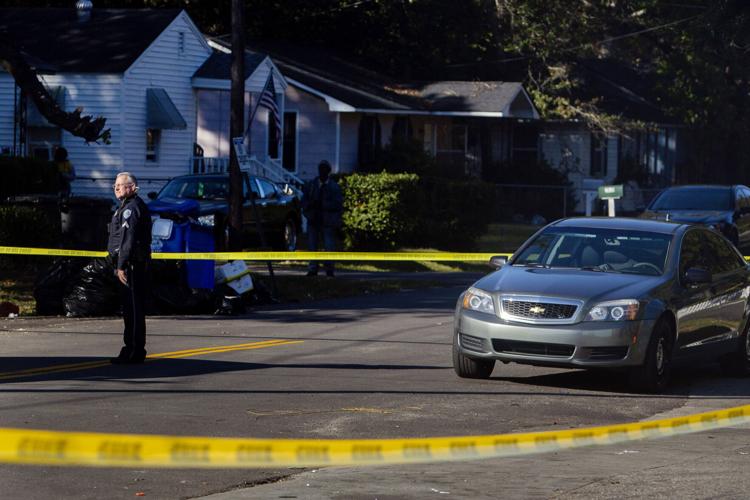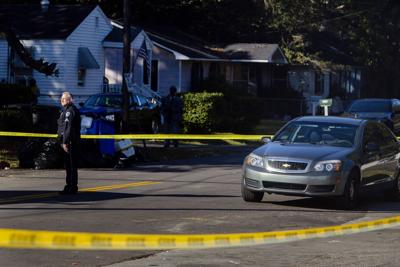This story is part of "Safety Off," an occasional series about gun violence in the Lowcountry.
NORTH CHARLESTON — Police and emergency responders scrambled on a recent Saturday night to treat and transport victims after the rat-a-tat of gunfire erupted three times within five hours throughout the city.
Detectives were still cataloging evidence at a crime scene Feb. 26 in the Dorchester Terrace neighborhood, where a 15-year-old boy was critically injured in a spray of gunfire that injured three others, when calls came in for shootings outside apartment buildings off McMillan Avenue and Hanahan Road.
Capt. Al Kuechler said investigators were put on standby after the McMillan Avenue shooting. Within minutes, officers were rushing to the reports of gunfire on Hanahan Road.
“Hey, it’s no longer standby. We need all y’all to come out here,” he told the team.
The toll was grim when the sun rose that Sunday: Two people were dead, including the teenager, and four others injured. It was a shock of violence in an already dangerous year. Seven homicides and 17 shootings would be reported by the end of the month.
Gun violence concerns often center around North Charleston, and for good reason.
The beleaguered city has struggled for years to contain gun violence, as internecine gang warfare and drug trafficking routinely drives the city’s homicide rate to levels unmatched in nearby communities.
And the problem has steadily gotten worse in recent years, crime data shows.
The city’s Police department tallied 36 homicides in 2021, the highest death toll in years. Thirty-four of those killings involved guns.
Shootings and aggravated assaults involving firearms have steadily increased in the past five years, according to the data.
Ninety-seven people were shot in 2017, compared with 120 victims last year, a 24 percent increase in shootings. Meanwhile, the number of aggravated assaults involving firearms rose 82 percent, from 247 reported offenses in 2017 to 451 offenses last year.
Not all aggravated assaults involving firearms result in shots fired. The offense is an aggregation of multiple gun-related crimes, including pistol-whipping, threats made with firearms, and shots fired into residences or vehicles that miss their target.
Gun crimes are rising in the Holy City.
Sixteen homicides were reported in Charleston in each of the past two years, a sharp increase for a city where killings usually hover around 10. Again, guns caused almost all of those deaths.
The number of aggravated assaults involving firearms more than doubled in Charleston during the past five years — 76 reported offenses in 2017 and 178 offenses in 2021. Shots were fired in 48-62 percent of those cases in recent years, the Police Department found.
Numbers for the Charleston County Sheriff's Office actually showed a decline in the number of aggravated assaults involving firearms, while homicides have remained steady after a spike in 2019. But the number of reported shootings has risen over the past five years.
Gun violence is rising in America’s urban areas, a trend experts say is contributing to a spike in homicides.
In 2020, South Carolina’s homicide rate reached levels unseen since the early 1990s, when the crack-cocaine epidemic ravaged cities and drove the homicide rate to record highs.
The nation’s homicide rate remains significantly lower than in South Carolina, but it has been on the rise in recent years after more than two decades of decline, including significant spikes in 2015 and 2020. The FBI has not yet released crime data for 2021.
Some public officials have claimed the spikes in killings are the result of “de-policing.”
The public outcry and civil unrest that followed the controversial police killings of Black residents around the country in recent years, including the August 2014 shooting of Michael Brown in Ferguson, Mo., made law enforcement officers more hesitant to actively investigate crimes and make arrests, they say. In 2015, Chicago Mayor Rahm Emanuel said police had gone “fetal” due to fears that a mistake could end their careers or create headlines.
Richard Rosenfeld, a professor at the University of Missouri in St. Louis, has studied crime for 50 years.
Rosenfeld looked at the de-policing theory in 2015 and found it suspect. While big-city police departments made fewer arrests for low-level offenses in 2015, arrest rates were already declining well before Brown’s death, according to his 2019 study. There was not a sharp drop in arrest rates in 2015, which would suggest police departments had retrenched.
So what has caused the homicide spikes?
Rosenfeld said one leading theory is that increased mistrust of police, particularly in communities of color, means residents are less willing to report crimes or assist with investigations.
Rosenfeld said a Gallup poll showed a big decline in public confidence in police after Ferguson, and again after George Floyd’s shooting in Minneapolis in May 2020, particularly among African Americans. But it’s harder to measure community mistrust than, say, the impact of arrests on homicides, he said.
While homicides are rising, the overall violent crime rate in America has remained steady and property crimes continue to fall.

Police investigate a shooting involving several victims near Hanover and Johnson streets in Charleston's East Side on July 28, 2021. File/Andrew J. Whitaker/Staff
“Clearly, something is singling out homicides and, to a lesser degree, non-fatal violent crime,” Rosenfeld said. “And the answer there is guns.”
The criminologist said he was speculating a little, but there has been emerging evidence to support the theory that more firearms on city streets is leading to more homicides.
Gun sales skyrocketed at the start of the pandemic, and again during the civil unrest that followed Floyd’s killing in Minneapolis, research shows.
A 2021 study from the University of Chicago Crime Lab found that Chicago police officers were recovering more illegally possessed guns during the pandemic, even while performing fewer street stops.
Researcher Jens Ludwig wrote in an April 2021 article for The Chicago Tribune announcing the lab’s findings that when illegal gun carrying increases, gun violence rises shortly thereafter.
“Our gun violence problem is, in part, an illegal gun carrying problem,” he said.
The COVID-19 pandemic and its destabilizing effect on communities and police departments has almost certainly had an effect on homicides, but the impact is complex, Rosenfeld said.
Fewer people out in the community should mean there are fewer opportunities for homicides to occur, Rosenfeld said, but joblessness and community disengagement do generally lead to higher homicide rates.
In a way, the pandemic has caused de-policing in communities, the criminologist said, but not because officer frustration led to less policing. Particularly at the pandemic’s start, waves of cops were forced into quarantine because of virus exposures, and social-distancing requirements meant police were less active on the street, Rosenfeld said.
North Charleston police officials pointed to several factors they believed were contributing to the city’s homicide spike, including the pandemic.
Social distancing isn’t really an option for detectives, Kuechler said. Detectives are in close contact with people constantly, and frequently find themselves at hospitals or in cramped interrogation rooms.
Detectives would interview someone at the hospital, only to learn afterward from a nurse the person was positive for COVID, Kuechler said. Lt. Tireka Wright said they saw the same thing in patrol — an officer would book a person at the jail and get a call an hour later saying the suspect tested positive.
Whole patrol teams would be impacted, the lieutenant said. That officer went into quarantine, and other officers were forced to pick up the slack.
Local law enforcement officials have emphasized the importance of community policing, including town halls and community events, as a way to reestablish trust with residents. But Wright said those efforts were severely curtailed during the pandemic.
The pandemic also had an outsized effect on already poor and disadvantaged communities. Charleston County Sheriff Kristin Graziano said the gun violence problem cannot be solved without addressing the myriad social factors that drive crime — joblessness, affordable housing and transportation, and community resources for the mentally ill.
“As big of a city as we are, we have horrible infrastructure,” Graziano said.
The pandemic made police work harder, but North Charleston police officials said other factors have played a role, including more violence tied to drug trafficking, in particular marijuana, and cheap gun modifications that make pistols spray bullets like machine guns.
Ken Hagge, deputy chief of investigations for North Charleston, said the legalization of marijuana in other states has led to an influx of potent pot in South Carolina that sells for more money. Higher prices mean more competition among gangs and more bloodshed, Hagge said. It also leads to more “rips,” or drug robberies, and disputes over bad products.

North Charleston Police Chief Reggie Burgess shows surveillance camera photos of a shooting at an Exxon on Ashley Phosphate Road in which a young child observed two men exchange gunfire when a man and woman met for a child custody drop-off. Burgess and nearly two dozen other people gathered at the intersection of Sumner Avenue and Attaway Street on July 2, 2019, where 21-year-old Ronald Simmons was shot Sunday night. Simmons later died of his injuries at Medical University Hospital. File/Brad Nettles/Staff
Officials said “gun switch” modifications also are being found more often on pistols. The illegal modifications turn pistols into less accurate, but more deadly, automatic weapons. A modified pistol combined with an extended magazine can fire off dozens of rounds in seconds, Hagge said.
Social media has also led to more deadly feuds among young people, officials said.
Graziano said people were “letting their fingers do the talking.”
“We've lost this piece of humanity that is really necessary to resolve a lot of disputes,” she said.
A big question for experts and law enforcement officials is whether homicides will continue to escalate, remain steady or fall again.
Rosenfeld said he is not sure anyone can say yet whether this is an anomaly or the new normal, but his inclination is that the recent homicide spikes are caused by unpredictable and extraordinary events – like the pandemic and civil unrest, that will eventually subside.
The crack-cocaine epidemic of the 1980s and early 1990s was an extraordinary event that caused crime rates to skyrocket, but then crime levels fell for almost 25 years afterward as the economy improved and racial segregation lessened, at least to some degree, Rosenfeld said.
North Charleston police officials said they believed there was a light at the end of the tunnel.
The community held peace walks in Dorchester Terrace and on McMillan Avenue to condemn the Feb. 26 shootings. At a March 18 town hall, local pastor and activist Thomas Dixon announced the launch of S.A.V.E., or Stand Against Violence Everywhere, a community organization dedicated to addressing gun violence.
North Charleston residents are sick of the violence, Kuechler said.
“I mean, who wants to live in a neighborhood, and you've been there for 20 years, and you can't sit on your front porch and drink coffee in the morning without worrying about shots being fired or someone getting shot?” the lieutenant said.













